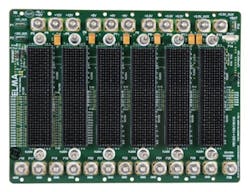MicroTCA looks to VME, CompactPCI, AdvancedTCA for converts to emerging small form factor standard
Within these markets, proponents of MicroTCA are hoping to attract interest from CompactPCI and VME users looking for a next-generation architecture that can deliver the increased performance, scalability, and longevity these aging architectures lack, as well as AdvancedTCA adherents that are looking for a less expensive - yet still robust - feature set in a much smaller footprint.
| Related stories -- Embedded computing standard for rugged, conduction-cooled MicroTCA systems announced by PICMG -- Place related story 2 headline here -- Place related story 3 headline here. |
OEMs that move to MicroTCA are going to do so because it is a next-generation architecture that delivers increased performance in a very small package. Although MicroTCA was introduced by the PCI Industrial Computer Manufacturers Group (PICMG) in 2006 there are already more than 50 companies worldwide offering Advanced Mezzanine Card (AMC) modules for the standard. This can be attributed to the fact that MicroTCA utilizes the same AMC cards as another PICMG effort -- AdvancedTCA -- which started in 2002.
MicroTCA is gaining traction quickly because it is an offshoot of AdvancedTCA; there is an overlap of the ecosystems in that regard and as a result, both architectures benefit.
The Move from AdvancedTCA
Perhaps the most logical migration path to MicroTCA lies with AdvancedTCA users looking for a lower cost solution and a smaller footprint.
The original intent of AdvancedTCA was to meet the requirements of the next generation of carrier grade wired and wireless networking and telecommunications equipment such as media gateways, video transcoders and IPTV. As a result, AdvancedTCA was created to deliver massive processing and bandwidth with high availability and built-in redundancy.
However, it has also been unofficially dubbed big iron due to its overall size. For many applications, AdvancedTCA may be overkill and the final solution is usually quite large. For those that prefer AdvancedTCA’s features, but don’t want to invest in unnecessary functions and are looking for a smaller footprint, MicroTCA is a natural choice.
With communication bandwidth capabilities in the range from 40 gigabits per second to faster than 1 terabit per second, MicroTCA has more than enough bandwidth for most demanding applications.
Starting with a small two-blade chassis and scaling up to a maximum 12 blade solution, 2U MicroTCA processors blades (PrAMCs) can be networked together to deliver a tremendous amount of computing resources, particularly when each could be designed with the latest multi-core processors to further increase computing power. Additional system components include power modules, cooling units, and AMCs for everything from mass storage to high end graphic cards.
Product applications for the MicroTCA architecture include wireless base stations, Wi-Fi/WiMAX radios, optical networks, and media servers, to name a few. OEM test and measurement equipment for network enterprise and wireless equipment are also well served by MicroTCA’s feature set.
MicroTCA also delivers the high reliability inherent in AdvancedTCA with availability up to five nines (0.999999). As with AdvancedTCA, redundancy and cooling configurations can be scaled for full, partial or no redundancy depending on the application’s requirements.
Next generation platform for VME and CompactPCI
Although VME and CompactPCI are still viable for many applications, these architectures are struggling to meet the demanding bandwidth requirements of today’s increasingly communication-centric industrial and military applications.
As a result, many VME and CompactPCI users are looking for that next generation platform that can deliver on both counts. MicroTCA has the added benefit of further decreasing the size of the final solution, with its 2U cards being smaller than VME and CompactPCI’s 3U and 6U offerings.
There are a lot of people that have been using VME and CompactPCI for a long time, pushing it along, keeping it going and now they face a decision to go to a new architecture and MicroTCA would be a good option because of its size and increased performance.
Making the Move to MicroTCA
To facilitate the move to MicroTCA, companies are going one step further to offer integrated solutions to help reduce the complexity, improve time to market, reduce risk to OEM partners by delivering application specific solution that meets the customer’s exact needs.
Such application-ready solutions drastically reduce integration time and costs and eliminate the need for customers to work with several vendors and integrate the components into a complete system themselves.
Customers may be used to dealing with several vendors, particularly with VME, Compact PCI, and AdvancedTCA, but in this economy with few resources, less time, and the need to get to market quickly, OEMs are searching for technology experts to help them reduce costs and improve time to market.
The modular embedded computing marketplace, including MicroTCA, can be difficult to navigate. The final solution will be an application specific solution that is assembled and pre-tested before it is delivered to the customer.
With an integrated solution, the customer can focus on higher levels of activity that bring them more value. So there are savings in terms of direct cost, savings in indirect costs and a reduction in risk factors.
Mark Lowdermilk is president and chief executive officer of Embedded Planet in Cleveland. Contact the company online at www.embeddedplanet.com.
